It’s hard to imagine a living room — or board room — where Netflix needs an introduction. Today, it boasts over 65 million subscribers across more than 40 countries. Even its culture document went viral to become part of startup canon. It spurs hundreds of cable cancellations daily.
Yet when former VP of Product Management Gibson Biddle joined Netflix in 2005, the product expert still had focus groups asking him: “Wait, I don’t get it. Do you mean streamlining?” No, streaming, he would say. No one knew what that meant. In the early days, building the company’s brand meant not only finding ways to promote and position the “brand promise” of Netflix, but also introducing — and owning — language that was fundamental to an incredibly new business. Beyond Netflix, Biddle has led and advised on brand creation and product development for landmark education and gaming companies, including Chegg, Sega and Mattel.
Biddle’s track record as a product leader stems from his ability to delight customers in hard-to-replicate, margin-enhancing ways. Network effects, economies of scale, and unique technology are commonly understood ways to create a hard-to-copy competitive advantage, but few understand the discipline required to define and build a brand.
Like a company’s mission or vision, a well-defined brand describes a “true north” that informs the company’s product development. And at world-class companies, you often see exceptional teamwork between marketing and product teams, where the marketing team defines the brand, and the product team helps bring it to life. Here, Biddle offers three simple and powerful tools to define an enduring brand starting now.
The Positioning Model
“A lot of people are intimidated by branding. They think, ‘I'm not an artist, I'm not a writer. I can't come up with something,’” says Biddle. There’s too many nebulous guidelines and abstract words thrown around about brand creation: “Brands should come from the heart.” “They are authentic and sustainable.” “The best are built with the strength of the human spirit, not an ad campaign.” None of this helps if you’re thinking about concrete deliverables.
For Biddle, Lean Branding author Laura Busche comes closest to an actionable definition:
A brand is the unique story that consumers recall when they think of you.
“This story associates your product with [your customers’] personal stories, a particular personality, what you promise to solve, and your position relative to your competitors,” Busche writes. “All human aspirations are opportunities for brands to build relationships.”
Aligned with Busche’s thinking, a positioning model will help you locate the place your brand should occupy in a consumer’s mind. First, answer these three questions about your company:
- What is it? Be descriptive.
- What are the customer benefits? How does it improve customers’ lives?
- What is its personality? If your product, company or service was human and you met at a cocktail party, how would you describe him/her?
Of course, there are levers and pitfalls to consider when answering each of these questions. To address these, Biddle has suggestions and illustrative examples to guide your process. Here, he uses snack subscription service Naturebox, which he advises, to illustrate concepts that have worked for him at Netflix and throughout his career.
Avoid positioning exercises alone or in silos.
Biddle works with startups in ways that leverage many minds at once. For example, during a workshop with employees at Naturebox, he divided the group into teams of six to apply his positioning model to the business. All participants reconvened to share their thoughts at the end of the hour. The objective of this exercise is to capture and articulate what others value about a company, so it’s critical to get many perspectives. It’s also helpful to track shared language across teams. Here are the initial answers from three of the groups at Naturebox:

So how can you start with something like this and arrive at crisp, unanimous positioning language?
Describe it to a sixth grader.
“Aim to be succinct and clear. Pretend you’re speaking with a sixth-grader. Your customers are busy so they don’t have time to parse fuzzy concepts. Your goal is not to dumb it down, but to tighten it up. ” Biddle challenged Group A to unpack “custom subscription snackbox.” One person offered: “Snackbox Delivered to Your Door.” That was too “salesy” for Biddle. “Snackbox Subscription Service.” That works. What would someone with zero context and limited knowledge of your business understand right away? Go with that.
Put your descriptions on a diet.
Biddle is strict on the economy of language in a positioning model. “Cut things down to three words maximum. Choose the most critical words.” At Naturebox, Biddle asked Group A to choose three of the four words describing their service so the team wouldn’t just list words, but carefully prioritize them. The team settled on “convenient,” “healthy,” and “variety.”
Don't stop until there's precision.
“There’s typically one fuzzy word in the bunch. Find that abstract word and dig deeper into it,” says Biddle. He prompted Group A to unpack “variety” until the team arrived at “choice” and then “selection.” “Selection” is a better fit for Naturebox, as the company aims to not only provide a range of products, but also a deliberate curation of healthy snacks.
“Don’t give an automatic pass to words that are popular across teams,” warns Biddle. “Everyone’s a suspect.” Both Groups A and B chose “unique.” “Unique in what way?” he persisted. “Its great taste — it’s tasty,” the team responded, providing a more exacting answer.
Introduce your company like you would a person.
Creating a personality for your company is one way to inspire emotions in people — one of the key concepts in building a memorable brand. “Ask yourself: If you met your company at a party, how would you describe it?” says Biddle. Two teams from Naturebox pitched the company’s personality as “a crowdpleaser” and “relatable.” “What does a crowdpleaser do — how would he or she act at a party? The company is relatable in what way?” pushed Biddle. The teams reframed Naturebox’s personality as “friendly and personable” and “down-to-earth.”
Decide on one word to own.
Companies that have successfully positioned their brand own a specific word in a consumer’s mind. “What’s the one word that you associate with each major car brand?” asks Biddle. “Honda is ‘reliability,’ Mercedes is ‘luxury,’ Volvo is ‘safety,’ BMW is ‘performance’ and Tesla is ‘innovative.’ We all instinctively relate these companies to these words, but it can take many decades for companies to ‘own’ a word — that is why I’m so impressed by Tesla as a young brand, this idea that they own innovation in the car industry at a relatively young age.”
Ten years from now, what word do you want to own?
Express the benefits from the point of view of the customer — not the company.
As you express your company’s benefits, always put — and root — yourself in your customers’ shoes. For example, Biddle remembers when online textbook rental company Chegg reached a milestone related to one of its customer benefits: saving money. The company was proud that the cumulative student savings for all Chegg customers for the year was $500 million. But in A/B testing on its homepage, that message didn’t convert well.
A/B testing demonstrated that the phrase “save hundreds of dollars” by renting instead of buying worked best, but it would have been a safe bet after returning to Chegg’s positioning framework. The $500 million savings said more about Chegg, but “saving hundreds of dollars” spoke more to students using the service.
The Branding Pyramid
After working through the positioning model, you’ve created language that will help define your brand for customers. “A company’s attributes, benefits and personality are the basic building blocks,” says Biddle. “For the consumer, they answer who you are, how you’ll improve my life and what it’s like to work with you, respectively.” But it takes a few more steps to deeply anchor your brand in a consumer’s mind. That brings you to the second model — the branding pyramid:

The difference between good and great brands is that they define emotional benefits and “something bigger” that they deliver. Biddle says, “Emotional benefits relate to the way in which I, as your customer, can gain confident control of my life by using you. The ‘something bigger’ speaks to what you aim to deliver to your customers, but also to the world in ten years. Like a company’s mission or vision, this brand promise or ‘something bigger’ should be inspirational and help define ‘true north’ for the brand and the product you’re building.”
By adding these elements to the positioning model, you’ve created a branding pyramid. It’s meant to be approached from bottom to top, with each section serving as the foundation for the one above it. Here are examples of the pyramid for three world-class brands:
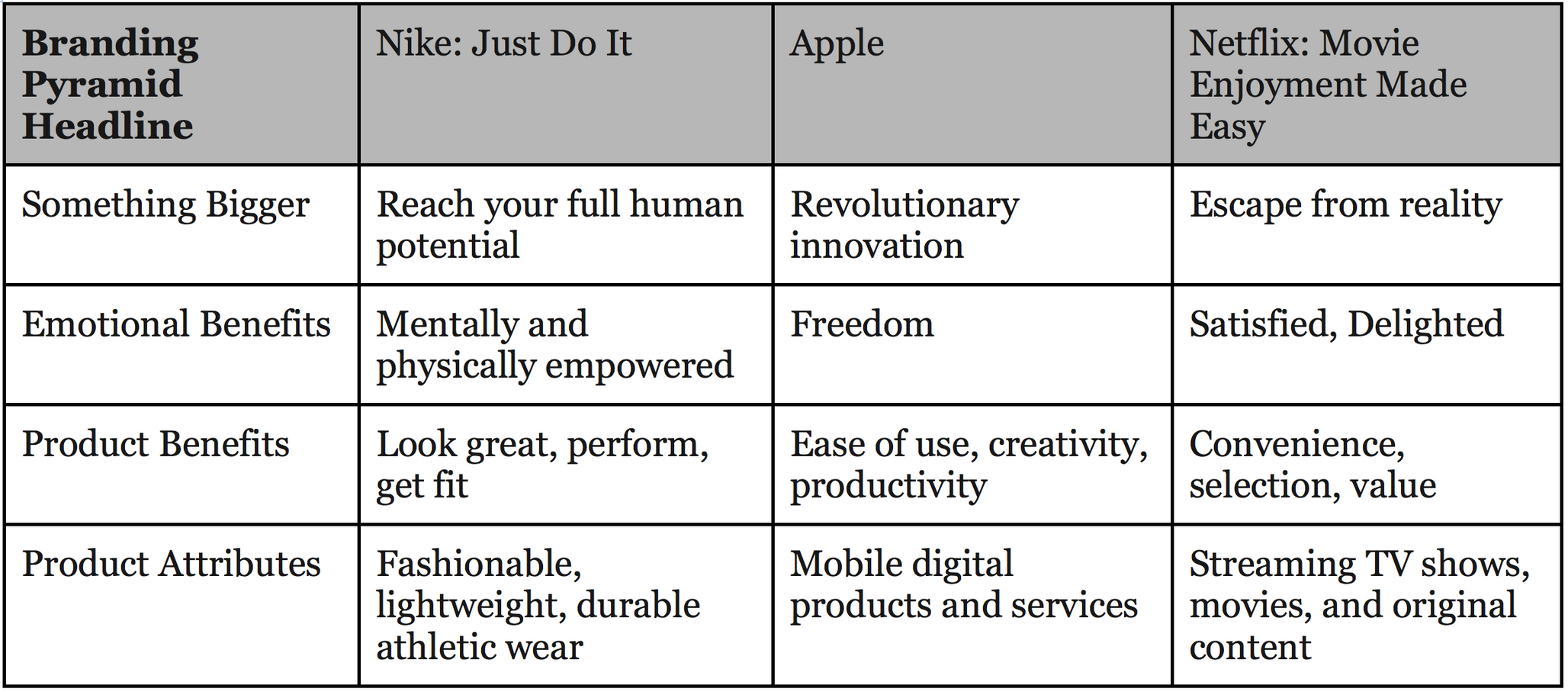
“The pyramid model is a way to 'level up’ from the attributes that define your product to the benefits it delivers. Then you can step into the emotional realm that makes a brand memorable. The ‘something bigger’ can anchor your brand for decades,” Biddle says. “At Netflix, what the product was changed over the years — from DVDs-by-mail, to streaming to original content. But the benefits — convenience, selection and value — remained the same. And the ‘something bigger’ — the escape from reality that a blockbuster summer movie delivered to each of us as kids — continues.”
The brand promise the product needed to deliver on could be described in four words: “Movie Enjoyment Made Easy.”
“It informed many of our product development decisions and defined a ’true north’ for product innovation,” he says. Biddle offers two pieces of advice to get the most out of the branding pyramid exercise:
Emotion is how you will be remembered.
When thinking about the role of emotion for brands, Biddle likes to reference Maya Angelou: “I’ve learned that people will forget what you said, people will forget what you did, but people will never forget how you made them feel.”
An emotion can be both a positive or negative sentiment, but it’s always personal, so it’s critical to choose wisely because it will stick. Think of your most embarrassing moment. No matter how long ago it was, you still remember it, and it still has the power to make you feel something, right?
In the context of a company, emotion is the bridge between how the product will benefit the consumer and how the company will benefit the world. It’s a lot of ground to cover, but the right emotion is powerful and memorable enough to link them together. “Emotion can transform a cold piece of technology into something that people deeply relate to in their lives,” says Biddle.
“Chegg started with textbook rental and grew into digital services, helping students save time, save money and get smarter,” says Biddle. “But the emotional benefit was about all the things that education can do for your life. Our products changed, but that emotional connection to self-improvement did not.”
Bet big on your "something bigger."
Reach your full human potential. Revolutionary innovation. Escape from reality. “Your company’s ‘something bigger’ should be a bold and lofty idea,” says Biddle. “The idea behind ‘something bigger’ is that it should capture your dream for the next decade and beyond. I don’t intend to be dramatic, but it’s true: It’s something you aspire to embody and plan to contribute to humanity.”
At the heart of “something bigger” is one question: What will you do for your customers — and more importantly, for the world at large? For Apple, that is delivering “revolutionary innovation.” Examples abound throughout its operations: market-changing consumer electronics, the distinctive design of its retail stores and its Think Different campaign featuring iconic changemakers such as Nelson Mandela, Albert Einstein and the Dalai Lama.
Brands are memorable for creating emotional connection, but they’re powerful when they deliver “something bigger.” Power means not only a lasting legacy, but also expressing more value. “For Nike, the brand goes beyond the emotional benefits of being mentally and physically empowered. Its something bigger is that it helps people reach their ‘full human potential.’ Will I pay $10 more for a pair of sneakers to become my best self? You bet I will. That’s the value of a brand.”
While there’s no cookie-cutter model for identifying that “something bigger” for your company, one of the best ways to arrive at it is to take a thorough look at how you arrived at your mission and vision. What emotional response do these statements provoke? Take those feelings and try to elevate them with language designed to appeal and deliver on your long-term promise to customers.
The Concept Summary
Once you’ve defined your positioning in the first model and how your brand levels up into the emotional realm, it’s time to represent your ideas to potential customers. Biddle is a strong advocate of brand hacking — building, testing and learning quickly. He points out that “words are cheap.” It’s easy to create multiple variations of a few key ideas — to develop a range of concept summaries — to see whether the language, and to some extent the ideas, resonate with customers.
A good concept summary takes all of the thinking from your positioning model, branding pyramid and internal discussions about what your company wants to be when it grows up — and reduces it to one paragraph. It must answer the question: Do people understand who I am, my benefits, my personality and the something bigger I will represent?
The goal is to put your work from the positioning and branding models into accessible, sixth-grade language, in order to begin a conversation with customers. “At Netflix, we came up with and tested dozens of concept summaries, but I won’t share them all with you,” says Biddle. “I’m going to make it look easy by sharing the ideas that clearly resonated with customers, and have represented the brand and product over the last 5-10 years.”
Here is a sample concept summary for Netflix:
Sometimes it’s hard to find a movie everyone can enjoy on a Friday night. For individuals and families with internet access, Netflix instantly streams an unlimited number of TV shows and movies, anytime, anywhere. Simply search, browse and watch on the easy-to-use website, mobile apps, apps on game platforms and hundreds of Internet-connected devices. With one-click anyone can watch ad-free, HD quality, TV shows and movies. It’s month-to-month and you can cancel anytime. We offer a one month free trial. Netflix, it’s movie enjoyment made easy.
The key idea in this concept summary, “Movie Enjoyment Made Easy,” is the core brand promise that the product team worked to deliver. A concept summary should be a dynamic document that is revisited — and leveraged — as a company grows. Here’s why a concept summary is so critical to your brand and the business:
It's a reliable gut-check when you make product decisions.
“When I first joined Netflix, it had no tagline,” says Biddle. “But the simple idea that my marketing partners drilled home was that we were about movie enjoyment made easy. You’re not likely to see that anywhere but in the concept summary and other internal brand materials that my marketing partners shared with me. But it was the essence of the product that we were trying to build to match our brand. I found it incredibly helpful as a product leader to return to it when making decisions.”
During Biddle’s time at Netflix, there was an internal debate about how to improve retention. The first option hinged on the premise that an entertaining, more cinematic experience would be the solution.
“Imagine you arrived at Netflix.com and the site literally talked to you,” says Biddle. “It was reminiscent of a game called You Don't Know Jack, a popular trivia video game. With clever writing scripted by the original game’s creators, the feature would engage viewers to answer questions in order to refine their movie tastes — a benefit for both the user and our recommendation algorithm. The approach was inspired by the constant fear on the product team that we would become a commodity. We wanted to create a wonderfully unique, cinematic experience.”
The reality is you're growing up as a company. You're getting smarter, better, faster. You're learning. At Netflix, my colleagues were constantly testing the non-member homepage — the page whose job is to convert potential customers into customers — every two weeks, forever.
The second option was more reminiscent of an automated vending machine that displayed the movies as tiles in rows across the screen — largely what you see today on the site. While the product team found this approach less interesting and technically challenging, it tested better quantitatively.
“It was good that we tried both options, but our concept summary might have delivered an early prediction. We needed to remember: Movie enjoyment made easy. This second option was the fastest, easiest way to get people into their movie experiences,” Biddle says. “Netflix differentiated itself by really pushing on convenience, selection and value — we went from a DVD delivery service to streaming TV shows and movies instantly on hundreds of devices for just $8 a month.
Your concept summary helps you communicate your brand more effectively.
For young companies building their brands, it’s common to express a lot about the company’s benefits or technology at the beginning. For example, Netflix used “watch instantly” in lieu of “streaming” until its consumers became familiar with the terminology.
As people become more familiar with your brand and technology, a lot of the work you need to do to communicate what your product is and the benefits it delivers falls away. In the early days of Netflix, the non-member homepage was complicated. But over time, as the brand grew and successfully embodied the notion of “Movie Enjoyment Made Easy,” the work of communicating to customers got easier and easier, and, consequently the non-member homepage got simpler.
It was a milestone when we realized that the information that was once on the homepage was now in our customers’ heads.
While at Netflix, Biddle saw the non-member homepage iterate quickly as the product evolved, the competitive landscape changed, and the world shifted from DVDs by mail to the now well-understood concept of streaming. “My colleagues were constantly A/B testing the non-member homepage, and, eventually, the simpler solutions began to test better,” says Biddle. “In other areas of our site, the simpler designs nearly always won, but on the non-member homepage, where we needed to communicate value, the denser designs still won. In the last few years, though, you can see how the non-member page got simpler and simpler. There’s more meaning embodied in the Netflix brand itself, so the non-member page doesn’t have to work as hard.”
Here is the evolution of Netflix’s home page over the last 15 years:
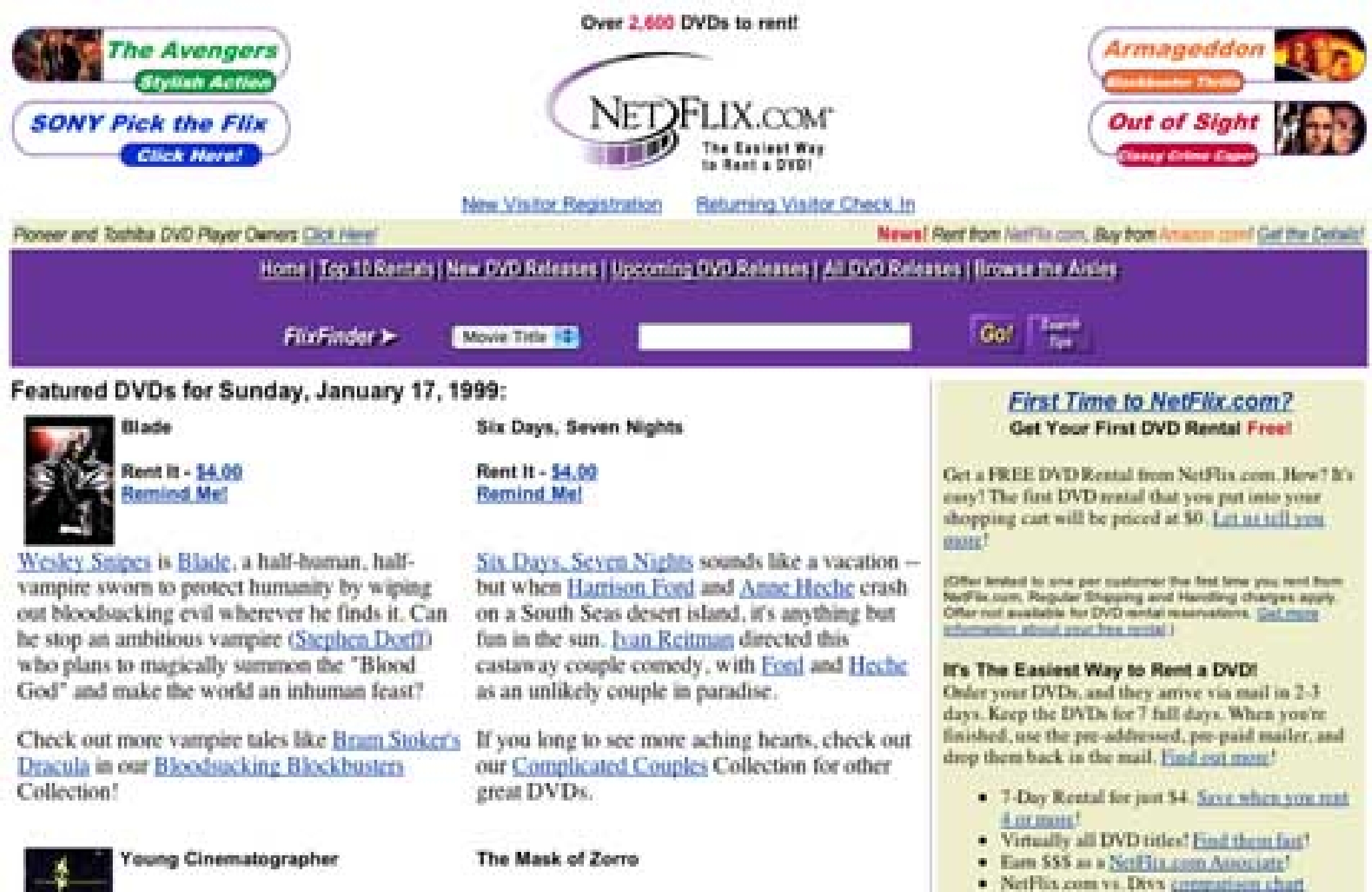

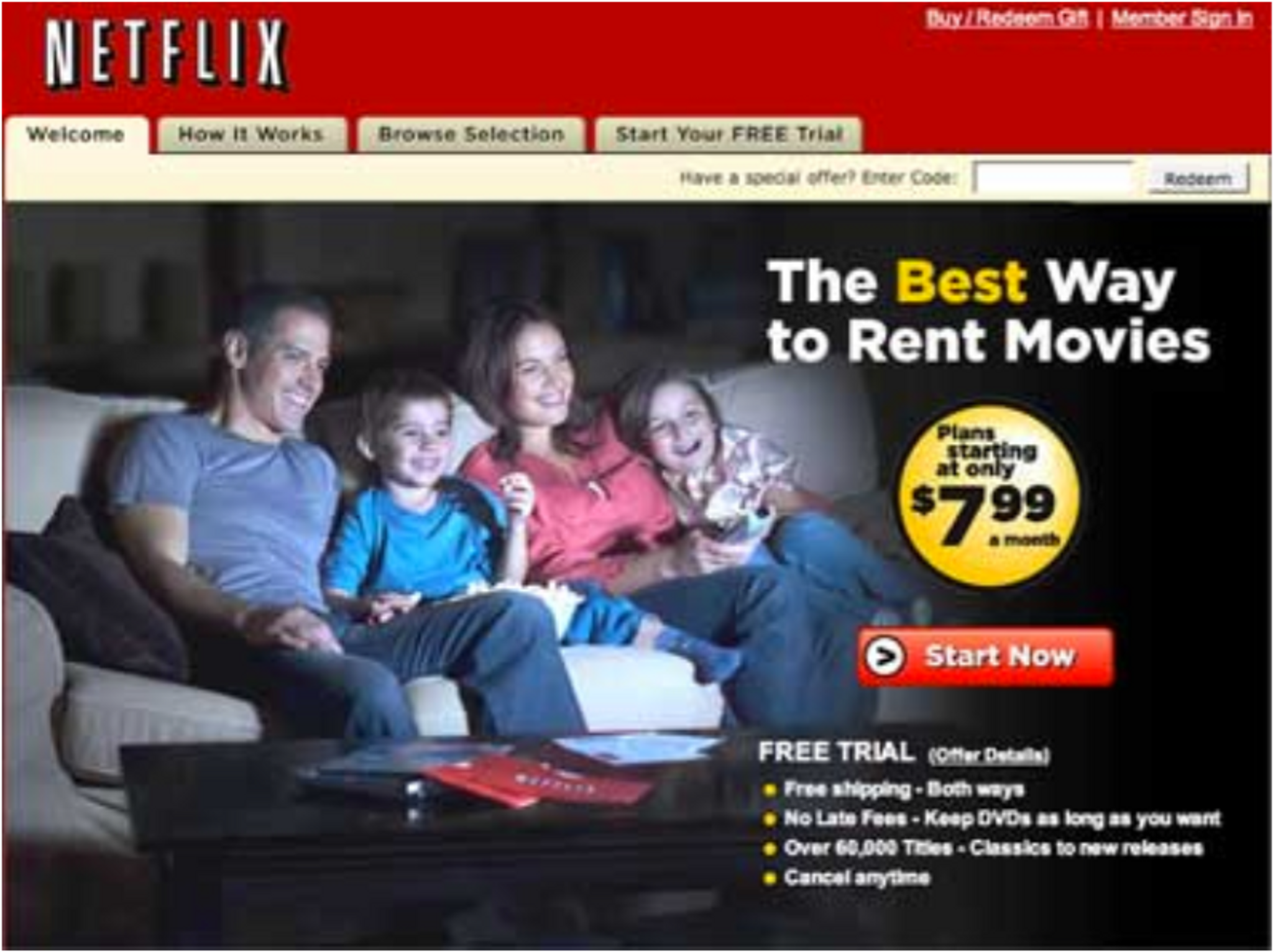
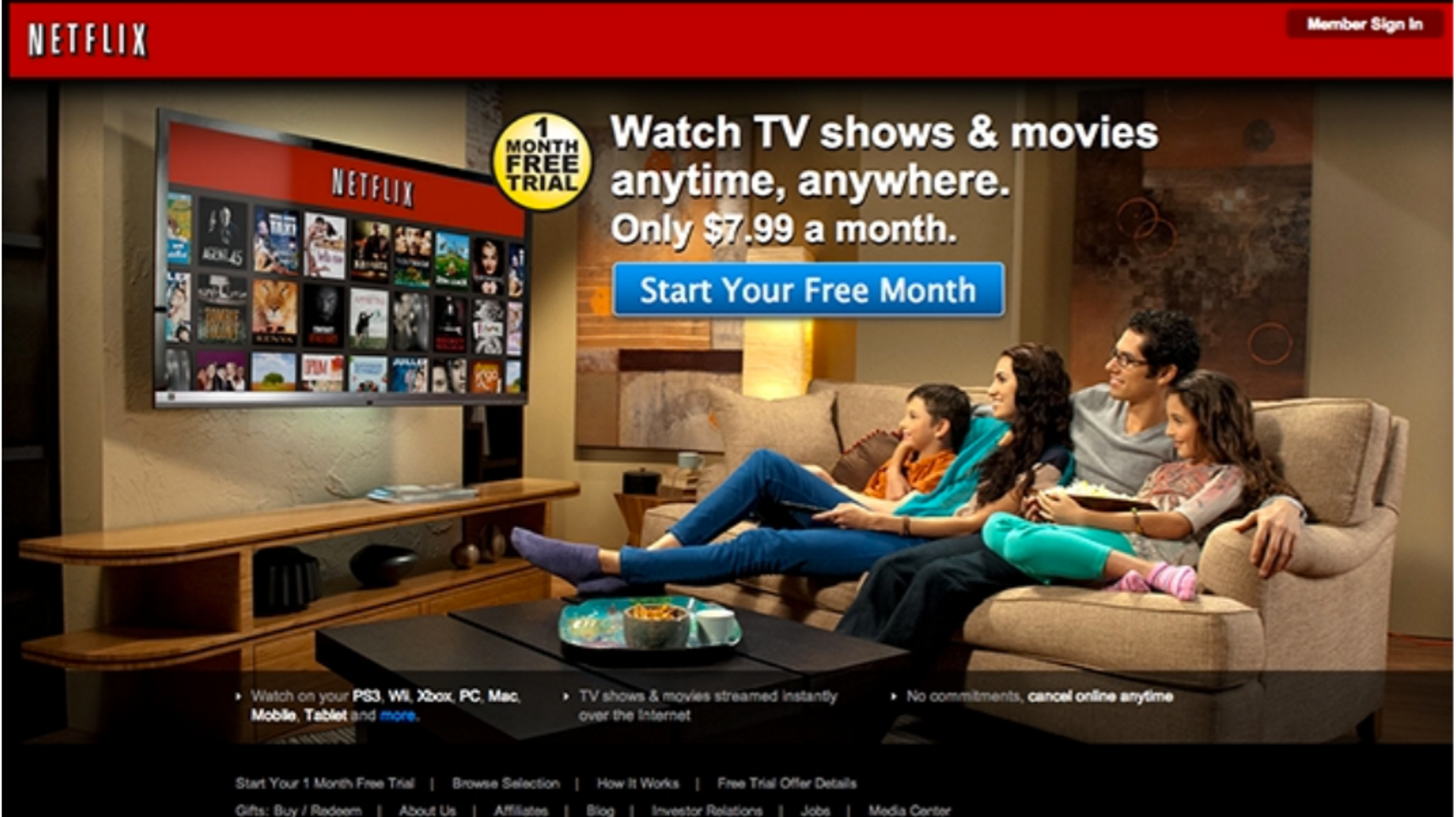
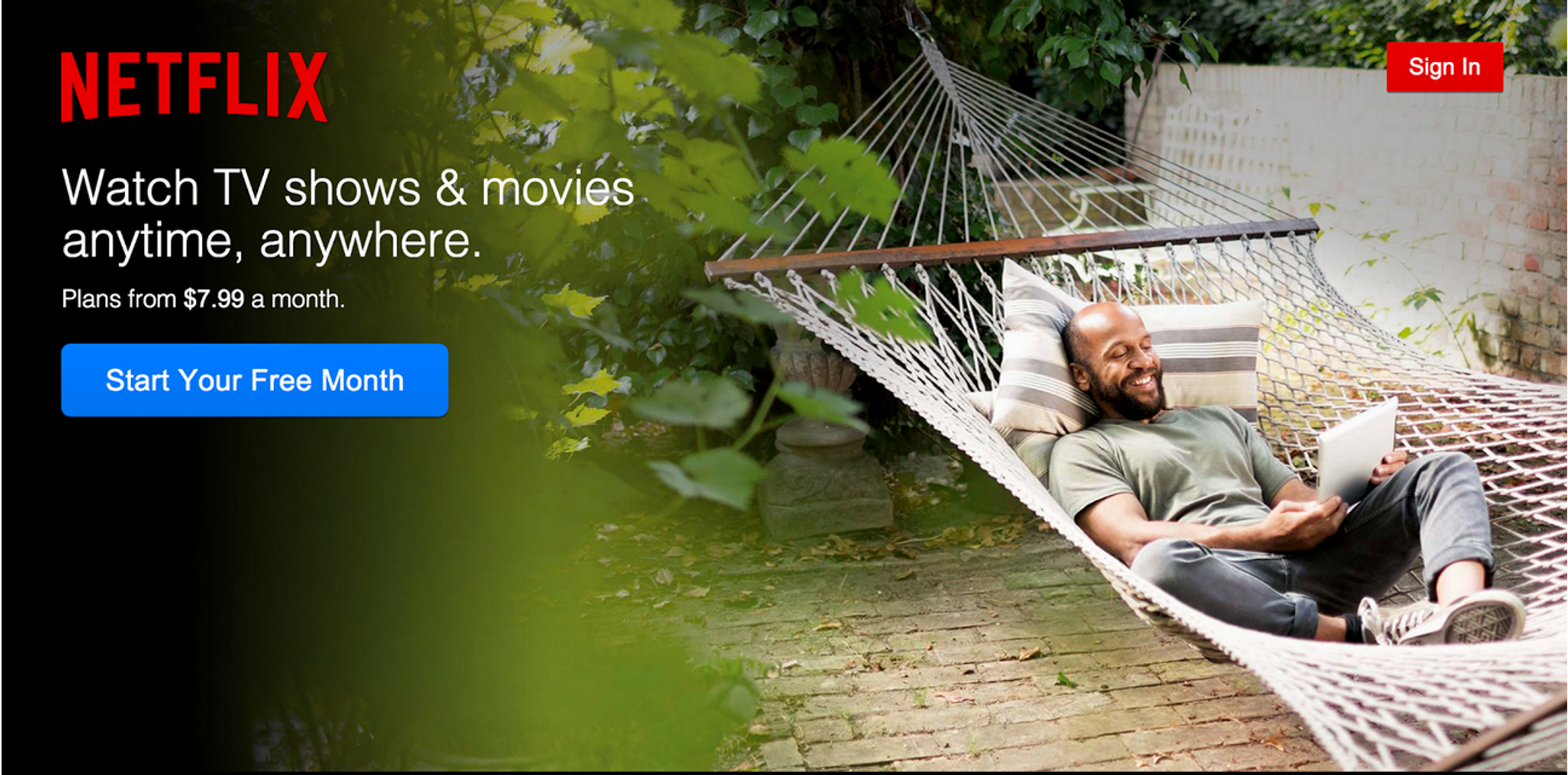
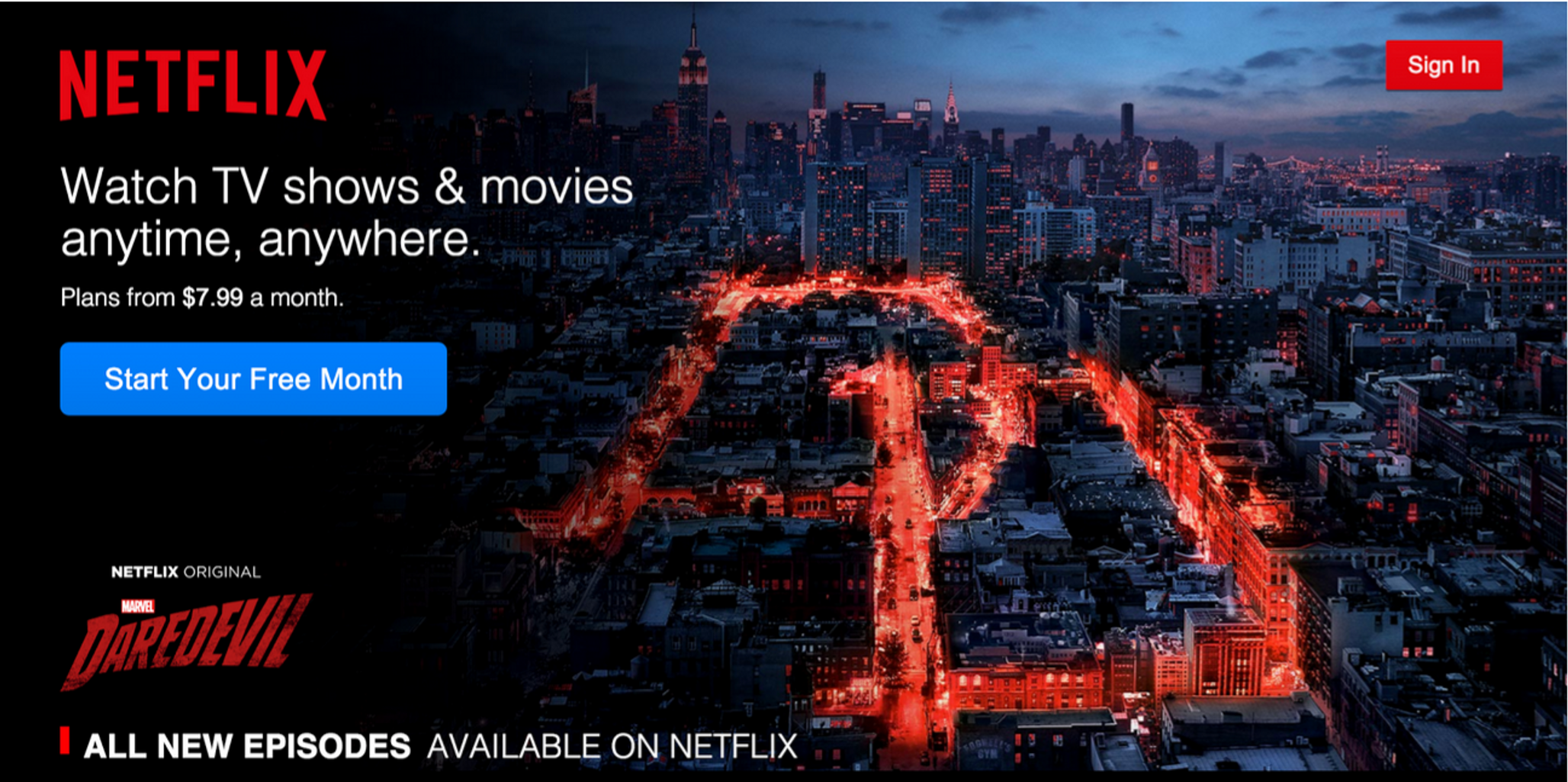
A good concept summary is a record of the timeless and temporal parts of your brand.
About a decade ago, Netflix offered a selection of 100,000 DVDs. Eight years ago, it introduced its streaming service. In recent years, it launched its first original television series. Through every transition, Netflix was always about movie enjoyment made easy. This brand promise captures both the timeless and changing elements of the brand.
“Product attributes are the one element that will change over time. The benefits will largely be the same. If you're really good in the early days, the emotional benefits for the customer will be constant. Even the ‘something bigger’ that you’re shooting for will stay the same,” says Biddle.
“Netflix has grown, but the non-member homepage continued to feature people on a couch — the embodiment of ‘movie enjoyment made easy’ — for more than a decade," says Biddle. "And today, things haven’t moved too far from that. If you look closely, today you’ll see a customer on a hammock, watching movies on an iPad. And it wouldn’t surprise me if the ‘Daredevil’ non-member homepage is a test — working to see if the promise of Netflix’s original content will inspire better conversion.”
This original content is a good example of a company’s attributes changing over time, but still delivering on that same brand promise.
A concept summary uses everyday, non-sales language to communicate elements of your brand pyramid and to explore what resonates with customers.
Biddle is careful not to choose one brand concept or another based solely on qualitative evidence. That’s the realm of A/B testing. He likes to extract the benefits from a concept summary and A/B test them on a company’s homepage to get customer feedback. Startups may not have the resources to hire a team of marketers to run focus groups for a year, but they can choose the customers they seek out.
“Find a way to talk to normal people about your concept summary. Use clear, simple language — without any Silicon Valley jargon. Speak with people outside of your zip code.” Biddle suggests using WebEx or GoToMeeting as cost-effective ways to have engaging conversations with customers located time zones away.
You’ll get some of your best ideas from everyday people and customers you’ve never thought to ask.
Ultimately, talking with customers about a range of potential concept summaries will help you avoid being clouded by pride of ownership in the product and company. “When it comes to A/B testing, it’s common to have a winner, but not know why. Conversations with real people begin to give you a sense of the why. I’ve never had a conversation with customers that didn’t spark a few ideas about where the product might go in the future.”
Don’t be afraid to let the voice of the real customer in; you must trust them to teach you. “I’ll say it again. Talk to real people. Not your mother, not your father, not your co-founder,” says Biddle. “Speak with 20 to 40 people not like you, and listen. At the end of the day, they may not sign up as your customer immediately. But they’ll reveal their way of thinking and show you their mind. And that’s exactly where you want your brand to blossom.”
